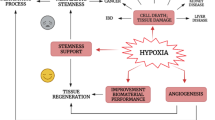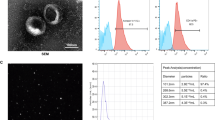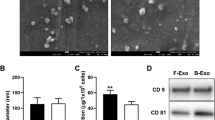Abstract
ADAMTS-2 and ADAMTS-3, known as procollagen amino proteases (PNP), are primarily responsible for processing the amino ends of the fibrillar collagen precursors. ADAMTS-2 is a highly expressed gene in type I collagen-rich tissues, such as skin, bones, tendons, and aorta. ADAMTS-3 is mainly expressed in cartilage, where it colocalizes with type II procollagen and in the nervous system. Studies about ADAMTS-2 and ADAMTS-3 enzymes primarily focused on their collagen processing activity. Knowledge about the transcriptional regulations of these genes is rather limited. Here we analyzed the transcriptional regulations of ADAMTS-2 and ADAMTS-3 genes under chemically induced hypoxic conditions in endothelial cell model, HUVECs. We elucidated that hypoxia is the potent positive regulator of ADAMTS-2 and ADAMTS-3 genes. qRT-PCR and western blotting studies revealed that ADAMTS-2 and ADAMTS-3 expressions were increased at mRNA and protein levels under chemically induced hypoxic conditions in HUVECs. In addition, Transient transfection experiments of ADAMTS-2 and ADAMTS-3 promoter–reporter constructs indicated that low oxygen conditions increased ADAMTS-2 and ADAMTS-3 promoter activities. Furthermore, the DNA–protein interaction assay provided evidence of the functional binding of HIF-1α on bioinformatically determined HRE regions on the ADAMTS-2 and ADAMTS-3 promoters.





Similar content being viewed by others
Data availability
All data generated or analyzed during this study are included in this published article (and its supplementary information files).
References
Gilkes DM, Semenza GL, Wirtz D (2014) Hypoxia and the extracellular matrix: drivers of tumour metastasis. Nat Rev Cancer 14:430–439
Naba A, Clauser KR, Ding H, Whittaker CA, Carr SA, Hynes RO (2016) The extracellular matrix: tools and insights for the “omics” era. Matrix Biol 49:10–24
van Kempen LC, Ruiter DJ, van Muijen GN, Coussens LM (2003) The tumor microenvironment: a critical determinant of neoplastic evolution. Eur J Cell Biol 82:539–548
Clarijs R, Ruiter DJ, de Waal RM (2003) Pathophysiological implications of stroma pattern formation in uveal melanoma. J Cell Physiol 194:267–271
Shao C, Yang F, Miao S, Liu W, Wang C, Shu Y, Shen H (2018) Role of hypoxia-induced exosomes in tumor biology. Mol Cancer 17:1–8
Huang Y, Lin D, Taniguchi CM (2017) Hypoxia inducible factor (HIF) in the tumor microenvironment: friend or foe? Sci China Life Sci 60:1114–1124
McKeown S (2014) Defining normoxia, physoxia and hypoxia in tumours—implications for treatment response. Br J Radiol 87:20130676
Fraley SI, Feng Y, Krishnamurthy R, Kim D-H, Celedon A, Longmore GD, Wirtz D (2010) A distinctive role for focal adhesion proteins in three-dimensional cell motility. Nat Cell Biol 12:598–604
Levental KR, Yu H, Kass L, Lakins JN, Egeblad M, Erler JT, Fong SF, Csiszar K, Giaccia A, Weninger W (2009) Matrix crosslinking forces tumor progression by enhancing integrin signaling. Cell 139:891–906
Cox TR, Bird D, Baker A-M, Barker HE, Ho MW, Lang G, Erler JT (2013) LOX-mediated collagen crosslinking is responsible for fibrosis-enhanced metastasis. Can Res 73:1721–1732
Chang HY, Nuyten DS, Sneddon JB, Hastie T, Tibshirani R, Sørlie T, Dai H, He YD, van Veer LJ, Bartelink H (2005) Robustness, scalability, and integration of a wound-response gene expression signature in predicting breast cancer survival. Proc Natl Acad Sci USA 102:3738–3743
Chang HY, Sneddon JB, Alizadeh AA, Sood R, West RB, Montgomery K, Chi J-T, Van De Rijn M, Botstein D, Brown PO (2004) Gene expression signature of fibroblast serum response predicts human cancer progression: similarities between tumors and wounds. PLoS Biol 2:e7
Lu P, Takai K, Weaver VM, Werb Z (2011) Extracellular matrix degradation and remodeling in development and disease. Cold Spring Harb Perspect Biol 3:a005058
Cawston TE, Young DA (2010) Proteinases involved in matrix turnover during cartilage and bone breakdown. Cell Tissue Res 339:221
Sun Y, Huang J, Yang Z (2015) The roles of ADAMTS in angiogenesis and cancer. Tumour Biol 36:4039–4051. https://doi.org/10.1007/s13277-015-3461-8
Li S-W, Arita M, Fertala A, Bao Y, Gc K, Tk L, Mm H, Dj HHAP (2001) Transgenic mice with inactive alleles for procollagen N-proteinase (ADAMTS-2) develop fragile skin and male sterility. Biochem J 355:271–278
Colige A, Sieron AL, Li S-W, Schwarze U, Petty E, Wertelecki W, Wilcox W, Krakow D, Cohn DH, Reardon W (1999) Human ehlers-danlos syndrome type VII C and bovine dermatosparaxis are caused by mutations in the procollagen I N-proteinase gene. Am J Human Genet 65:308–317
Alper M, Kockar F (2014) IL-6 upregulates a disintegrin and metalloproteinase with thrombospondin motifs 2 (ADAMTS-2) in human osteosarcoma cells mediated by JNK pathway. Mol Cell Biochem 393:165–175
Aydemir AT, Alper M, Kockar F (2018) SP1-mediated downregulation of ADAMTS3 gene expression in osteosarcoma models. Gene 659:1–10. https://doi.org/10.1016/j.gene.2018.03.009
Turkoglu SA, Kockar F (2016) SP1 and USF differentially regulate ADAMTS1 gene expression under normoxic and hypoxic conditions in hepatoma cells. Gene 575:48–57. https://doi.org/10.1016/j.gene.2015.08.035
Tokay E, Sagkan RI, Kockar F (2020) TNF-alpha induces URG-4/URGCP gene expression in hepatoma cells through starvation dependent manner. Biochem Genet. https://doi.org/10.1007/s10528-020-09972-z
Alper M, Köçkar F (2012) Effects of fibroblast growth factor (FGF acidic) and epidermal growth factor (EGF) on procollagen-N proteinases; ADAMTS-2 and ADAMTS-3 in osteosarcoma model
Livak KJ, Schmittgen TD (2001) Analysis of relative gene expression data using real-time quantitative PCR and the 2−ΔΔCT method. Methods 25:402–408
Hacıoğlu N, Güngör T, Tokay E, Önder FC, Ay M, Köçkar F (2020) Synthesis and biological evaluation of 2,4,6-trinitroaniline derivatives as potent antitumor agents. Monatshefte für Chemie-Chem Mon 151:1629–1641
Yıldırım H, Karaman M, Köçkar F (2017) The role of hypoxia response element in TGF beta-induced carbonic anhydrase IX expression in Hep3B human hepatoma cells. Arch Biol Sci 69(4):593–601
Okuyan D, Turkoglu SA, Kockar F (2020) Carbonic anhydrase III is a new target of HIF1α in prostate cancer model. Gene 762:145034
Tokay E, Kockar F (2016) SP1 is a transcriptional regulator of URG-4/URGCP gene in hepatocytes. Mol Cell Biochem 423:75–83
Alper M, Aydemir AT, Köçkar F (2015) Induction of human ADAMTS-2 gene expression by IL-1α is mediated by a multiple crosstalk of MEK/JNK and PI3K pathways in osteoblast like cells. Gene 573:321–327
Hatipoglu OF, Hirohata S, Cilek MZ, Ogawa H, Miyoshi T, Obika M, Demircan K, Shinohata R, Kusachi S, Ninomiya Y (2009) ADAMTS1 is a unique hypoxic early response gene expressed by endothelial cells. J Biol Chem 284:16325–16333
Hirohata S, Hatipoglu FO, Miyoshi T, Ogawa H, Obika M, Kamikawa S, Kusachi S, Itoh H, Ninomiya Y (2009) ADAMTS-1 is an endothelial cell-specific hypoxia-inducible gene. Am Heart Assoc 120:S1172
Kumar S, Rao N, Ge R (2012) Emerging roles of ADAMTSs in angiogenesis and cancer. Cancers 4:1252–1299. https://doi.org/10.3390/cancers4041252
Tortorella MD, Malfait F, Barve RA, Shieh HS, Malfait AM (2009) A review of the ADAMTS family, pharmaceutical targets of the future. Curr Pharm Des 15:2359–2374. https://doi.org/10.2174/138161209788682433
Dubail J, Kesteloot F, Deroanne C, Motte P, Lambert V, Rakic J-M, Lapiere C, Nusgens B, Colige A (2010) ADAMTS-2 functions as anti-angiogenic and anti-tumoral molecule independently of its catalytic activity. Cell Mol Life Sci 67:4213–4232
Jeltsch M, Jha SK, Tvorogov D, Anisimov A, Leppänen V-M, Holopainen T, Kivelä R, Ortega S, Kärpanen T, Alitalo K (2014) CCBE1 enhances lymphangiogenesis via a disintegrin and metalloprotease with thrombospondin motifs-3–mediated vascular endothelial growth factor-C activation. Circulation 129:1962–1971
Sun Z, Liu Y, Liang H, Li Y, Wang D, Tian J (2018) Interleukin-1β exacerbates the catabolic effects of human nucleus pulposus cells through activation of the nuclear factor kappa B signaling pathway under hypoxic conditions. Eur Rev Med Pharmacol Sci 22:7129–7139
Michiels C, Arnould T, Remacle J (2000) Endothelial cell responses to hypoxia: initiation of a cascade of cellular interactions. Biochim Biophys Acta 1497:1–10. https://doi.org/10.1016/s0167-4889(00)00041-0
Shan Y, You B, Shi S, Shi W, Zhang Z, Zhang Q, Gu M, Chen J, Bao L, Liu D, You Y (2018) Hypoxia-induced matrix metalloproteinase-13 expression in exosomes from nasopharyngeal carcinoma enhances metastases. Cell Death Dis 9:382. https://doi.org/10.1038/s41419-018-0425-0
Dengler VL, Galbraith M, Espinosa JM (2014) Transcriptional regulation by hypoxia inducible factors. Crit Rev Biochem Mol Biol 49:1–15. https://doi.org/10.3109/10409238.2013.838205
Schodel J, Oikonomopoulos S, Ragoussis J, Pugh CW, Ratcliffe PJ, Mole DR (2011) High-resolution genome-wide mapping of HIF-binding sites by ChIP-seq. Blood 117:e207–e217. https://doi.org/10.1182/blood-2010-10-314427
Schodel J, Mole DR, Ratcliffe PJ (2013) Pan-genomic binding of hypoxia-inducible transcription factors. Biol Chem 394:507–517. https://doi.org/10.1515/hsz-2012-0351
Mole DR, Blancher C, Copley RR, Pollard PJ, Gleadle JM, Ragoussis J, Ratcliffe PJ (2009) Genome-wide association of hypoxia-inducible factor (HIF)-1alpha and HIF-2alpha DNA binding with expression profiling of hypoxia-inducible transcripts. J Biol Chem 284:16767–16775. https://doi.org/10.1074/jbc.M901790200
Xia X, Kung AL (2009) Preferential binding of HIF-1 to transcriptionally active loci determines cell-type specific response to hypoxia. Genome Biol 10:R113. https://doi.org/10.1186/gb-2009-10-10-r113
Villar D, Ortiz-Barahona A, Gomez-Maldonado L, Pescador N, Sanchez-Cabo F, Hackl H, Rodriguez BA, Trajanoski Z, Dopazo A, Huang TH, Yan PS, Del Peso L (2012) Cooperativity of stress-responsive transcription factors in core hypoxia-inducible factor binding regions. PLoS ONE 7:e45708. https://doi.org/10.1371/journal.pone.0045708
Acknowledgements
Saos-2, MG-63, and HUVEC cells were from ATCC. Laboratories at Balıkesir University, Molecular Biology and Genetics Department were used for the experiments
Funding
The authors declare that no funds, grants, or other support were received during the preparation of this manuscript.
Author information
Authors and Affiliations
Contributions
All authors contributed to the study’s conception and design. Material preparation, data collection, and analysis were performed by CA, MA, and FK. The first draft of the manuscript was written by CA, MA, and FK and all authors commented on previous versions of the manuscript. All authors read and approved the final manuscript.
Corresponding author
Ethics declarations
Conflict of interest
The authors have no relevant financial or non-financial interest to disclose.
Ethical approval
The article contains no research in which animals were used.
Additional information
Publisher's Note
Springer Nature remains neutral with regard to jurisdictional claims in published maps and institutional affiliations.
Supplementary Information
Below is the link to the electronic supplementary material.
Rights and permissions
Springer Nature or its licensor holds exclusive rights to this article under a publishing agreement with the author(s) or other rightsholder(s); author self-archiving of the accepted manuscript version of this article is solely governed by the terms of such publishing agreement and applicable law.
About this article
Cite this article
Altuntaş, C., Alper, M., Keleş, Y. et al. Hypoxic regulation of ADAMTS-2 and -3 (a disintegrin and matrix metalloproteinase with thrombospondin motifs 2 and 3) procollagen N proteinases by HIF-1α in endothelial cells. Mol Cell Biochem 478, 1151–1160 (2023). https://doi.org/10.1007/s11010-022-04549-3
Received:
Accepted:
Published:
Issue Date:
DOI: https://doi.org/10.1007/s11010-022-04549-3




